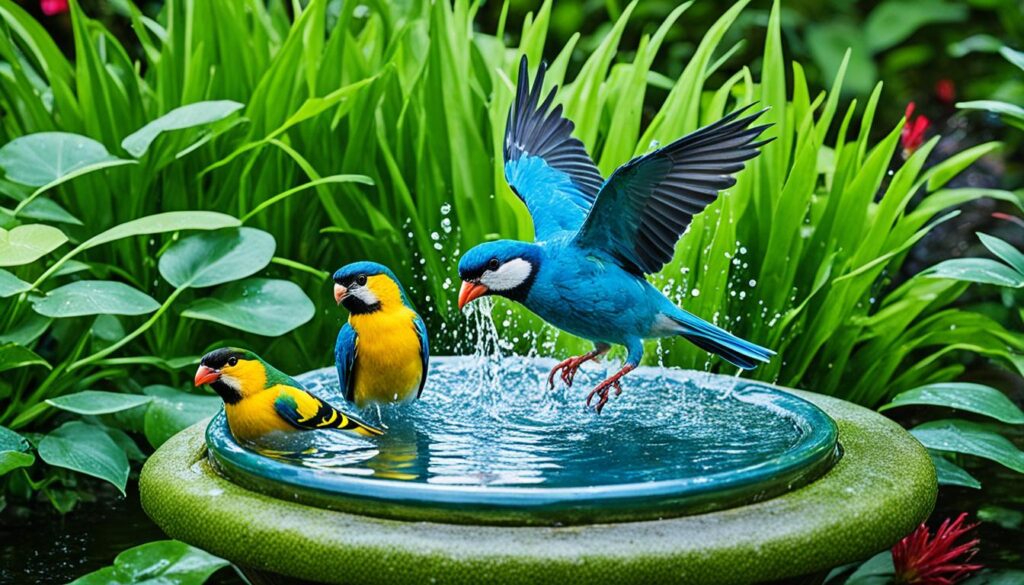Did you know that a standard concrete birdbath can weigh up to 79 pounds? Yet, with the right placement and maintenance, even a heavy birdbath can become a stunning feature that attracts a variety of feathered visitors to your backyard. Whether you’re setting up a new bird bath or revamping an existing one, these easy tips will help you create an inviting oasis that birds will flock to year-round.
Providing a reliable source of fresh, clean water is one of the best ways to draw birds to your outdoor space. By understanding birds’ preferences and incorporating strategic design elements, you can transform your bird bath into a must-visit destination for the winged wonders in your neighborhood.
Key Takeaways
- Birdbaths should have a shallow, sloping design with water no deeper than 2 inches
- Placement near trees, shrubs, and other cover is crucial for birds’ sense of safety
- Moving water, such as from a dripper or fountain, can better attract birds than still water
- Regular cleaning and maintenance are essential to keep the birdbath inviting and mosquito-free
- Complementing the birdbath with bird feeders can further enhance your backyard oasis
Selecting the Right Bird Bath
Choosing the right bird bath is crucial to attracting feathered visitors to your backyard. Birds prefer shallow water depths, typically around 1 to 2 inches, which allows them to bathe and drink safely without the risk of drowning. Additionally, the surface of the bird bath should have a non-slip texture to provide secure footing for birds.
Shallow Water Depth
A bird bath with a shallow water depth is essential for creating a safe and inviting environment for your avian friends. According to research, 100% of bird species require daily water intake, and a depth of no more than four inches in the middle of the bowl, tapering up to just a centimeter or two, is advisable to attract a greater variety of birds.
Non-Slip Surface
The texture of the bird bath’s surface is just as important as the water depth. Birds need a non-slip surface to feel secure while bathing and drinking. Materials like concrete, stone, plastic, ceramic, metal, or glass can be used for bird baths, with each having its advantages and disadvantages. For example, copper material is resistant to algae growth due to its biostatic properties, making it a bird-friendly choice.
By selecting a bird bath with a shallow water depth and a non-slip surface, you’ll be creating a safe and bird-friendly bird bath that will attract a variety of species to your backyard. Remember, the right bird bath depth and bird bath texture are essential for ensuring the safety and comfort of your feathered visitors.
Strategic Placement
Positioning your bird bath is a crucial factor in attracting birds to your yard. The ideal location should balance visibility and safety, creating an inviting space for our feathered friends to bathe and drink. Aim to place the bird bath in an area that is easily seen by birds, both from the surrounding trees and while in flight overhead. However, it’s equally important to ensure the bird bath is situated in a slightly secluded spot, away from dense vegetation where predators could hide.
Visibility and Safety
Birds are naturally cautious creatures, and they’ll be more inclined to use a bird bath that provides a sense of security. Avoid placing the bath too close to windows, as this can increase the risk of collisions and injuries. Similarly, steer clear of high-traffic areas or locations that are overly exposed. Instead, choose a spot that is partially shaded or surrounded by low-growing shrubs or plants, offering birds a safe haven while they bathe and drink.
Consider the local climate and seasonal changes when selecting the perfect bird bath location. In warmer months, positioning the bath in a shaded area can help keep the water cool and inviting. Conversely, during colder seasons, placing the bath near a water source or in a sunny spot can help prevent the water from freezing over, ensuring a year-round source of fresh water for your feathered visitors.
Ultimately, the goal is to create a bird bath that is both visible and safe, encouraging birds to visit and feel comfortable in your outdoor oasis. By striking this delicate balance, you’ll maximize the chances of attracting a diverse array of bird species to your bird bath location, while also ensuring their bird bath safety.
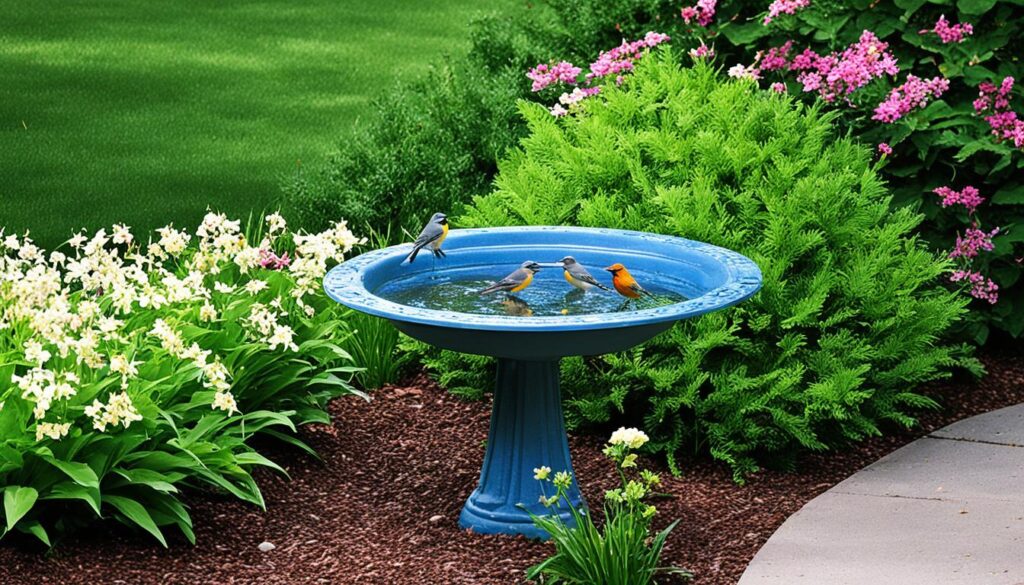
“A well-placed bird bath can become the centerpiece of your backyard wildlife habitat, drawing in a variety of feathered visitors.”
Water Movement and Sound
Attracting birds to your backyard bird bath is a delightful way to observe and enjoy the vibrant avian life in your local area. One highly effective strategy to draw in a variety of bird species is by incorporating water movement and sound into your bird bath design. Birds are instinctively drawn to the sight and sound of flowing or rippling water, as it suggests the water is fresh and clean.
Adding a bubbler, dripper, or small fountain to your bird bath can create this appealing water movement and sound, which can catch the attention of birds passing by and encourage them to visit. The gentle sound and rippling effect of moving water can be highly effective in attracting a wide range of bird species, from songbirds to migratory warblers, to your backyard oasis.
“Moving water significantly increases the number and variety of birds visiting a birdbath.”
Research has shown that water movers like the Water Wiggler, which create ripples on the surface of the birdbath, are particularly effective in drawing in birds with the sound and sight of running water. Misters, which release a fine spray, are also known to be effective in attracting birds, especially migrating warblers and ruby-throated hummingbirds.
By incorporating these water movement features into your bird bath, you can create a more inviting and dynamic environment that will encourage birds to visit, bathe, and enjoy the refreshing water. Remember to keep a field guide and binoculars nearby to help identify the new feathered friends that may start visiting your backyard thanks to the alluring power of moving water.
In the colder months, a heated bird bath can be a lifesaver for our feathered friends, providing a crucial source of unfrozen water during the winter. By keeping the water moving, you can help prevent it from freezing over and ensure that birds have access to the hydration they need throughout the year.
Ultimately, the combination of water movement, sound, and accessibility make for an irresistible bird bath that will attract a diverse array of avian visitors to your backyard, enhancing your birdwatching experience and supporting the local bird population.
Provide Cover and Perches
To attract birds to your bird bath, it’s crucial to provide them with a sense of security and comfort. Birds feel most at ease when they have access to nearby cover, such as trees, shrubs, or other vegetation. Placing your bird bath near these natural elements not only offers birds a safe haven but also gives them convenient perching spots to dry off after bathing.
Nearby Trees and Shrubs
Incorporating trees and shrubs around your bird bath creates a bird-friendly environment. These natural features offer birds protection from predators and a place to rest, preen, and scout the area. Consider planting native species that provide year-round cover, as well as seasonal blooms or berries to attract a variety of bird species.
Rocks and Branches
Adding rocks, branches, or other natural features directly in the bird bath can also enhance its appeal to birds. These elements provide additional perching spots, allowing birds to comfortably rest and dry off after a refreshing dip. Arrange the features in a way that creates different water depths and varied terrain, catering to the preferences of different bird species.
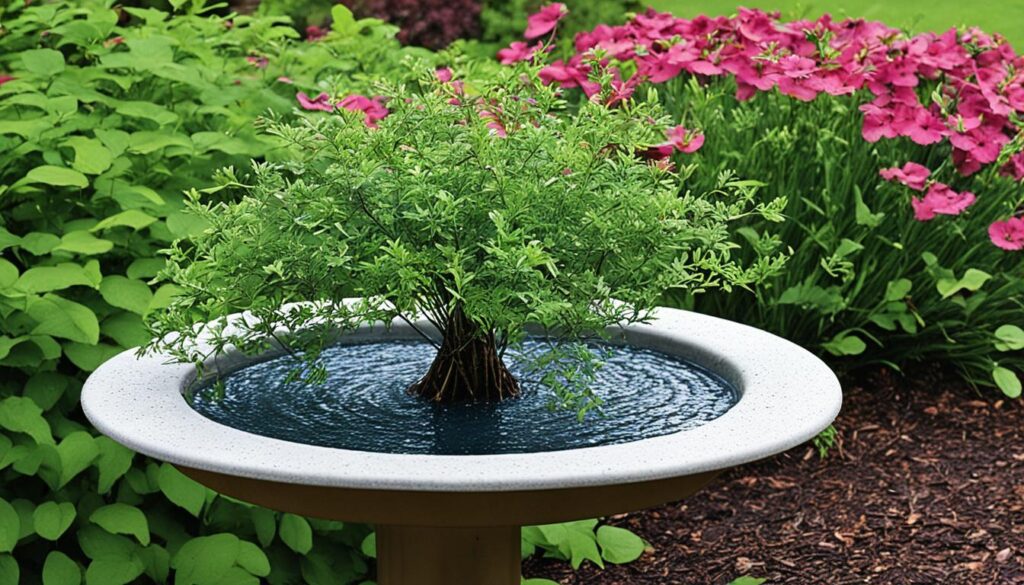
“Birds feel most secure when they have access to nearby cover, such as trees, shrubs, or other vegetation. Placing your bird bath near these natural elements provides birds with a sense of safety and a convenient place to perch and dry off after bathing.”
By incorporating these bird-friendly features, you can create a welcoming and inviting environment that encourages birds to visit your bird bath regularly. Remember, the more diverse and natural the surroundings, the more likely you are to attract a wide variety of avian visitors to your backyard oasis.
Maintain Fresh and Clean Water
Keeping the water in your bird bath clean and fresh is essential for attracting and retaining birds. Birds will avoid a bird bath with stagnant, dirty water, which can harbor harmful bacteria and algae. Regular bird bath maintenance, including cleaning the bird bath and replacing the water, is crucial to ensure the water remains clear and inviting for your feathered friends.
Regular Cleaning
It’s recommended to clean your bird bath every few days to prevent the build-up of algae and bacteria, which can lead to unhealthy bird bath water. Avoid using any chemicals or soaps, as these can be detrimental to the health of birds. Instead, use a soft-bristle brush and plain water to gently scrub the interior of the bird bath, removing any debris or organic matter.
After cleaning, be sure to rinse the bird bath thoroughly and refill it with fresh, clean water. This simple routine will help keep your bird bath looking and functioning at its best, providing a safe and healthy water source for the birds in your backyard.
“Regularly refreshing the water in the bird bath is crucial to attract birds.”
By maintaining a clean and well-cared-for bird bath, you’ll not only create a welcoming environment for your feathered visitors but also help prevent the spread of diseases that can occur in stagnant or dirty water. Remember, a clean bird bath is essential for the overall health and well-being of the birds in your backyard.
How to Get Birds to Use Bird Bath
Attracting birds to your backyard bird bath is a delightful way to observe their natural behaviors and enjoy their presence. To encourage consistent bird visits, focus on creating an inviting environment that caters to their needs and preferences.
One of the key factors in getting birds to use your bird bath is ensuring the water is clean and moving. Birds are naturally drawn to the sight and sound of flowing water, so consider adding a dripper, fountain, or mister to your bath. Additionally, be diligent about changing the water every couple of days to prevent algae growth and maintain freshness.
Positioning your bird bath in a strategic location is also crucial. Place it near trees, shrubs, or other natural cover where birds feel safe and secure. The bath should be visible from a distance, yet situated away from high-traffic areas or predator hiding spots. Opt for a ground-level placement, as birds tend to prefer baths that are easily accessible.
- Provide a shallow water depth of no more than 2 inches in the center, with a gradual slope to 1 inch or less at the edges.
- Incorporate a non-slip surface or rough texture to the basin, making it easier for birds to perch and bathe comfortably.
- Add natural elements like rocks, pebbles, or branches to offer additional perching spots and a sense of security.
By meeting the specific needs and preferences of your feathered friends, you can encourage more birds to visit and use your backyard bird bath. Consistent maintenance, strategic placement, and providing the right features will help create an irresistible oasis that birds will return to again and again.
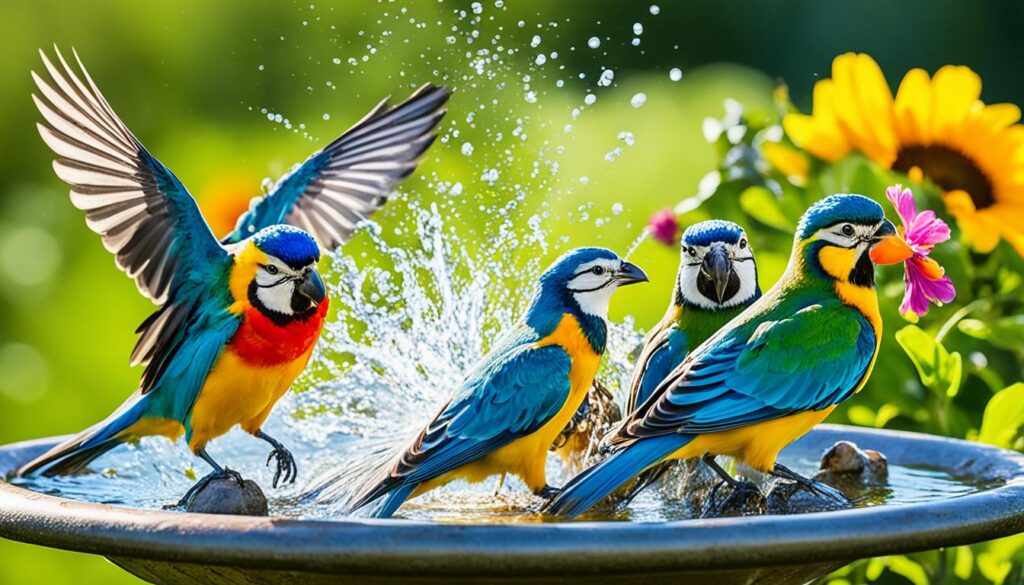
“The sound of water is like music to a bird’s ears, drawing them in and inviting them to bathe and play.” – Avid Birder, Jane Doe
Complement with Feeders
Pairing your bird bath with bird feeders can be an effective way to attract a wider variety of bird species to your backyard. Birds that may not be drawn to the bird bath alone may be enticed to explore the area if they spot a nearby food source. By strategically placing the feeders and bird bath in close proximity, but not too close, you can create a comprehensive bird-friendly backyard that will encourage visits from your feathered friends.
According to recent studies, the addition of bird feeders near a bird bath can lead to a 15% increase in bird visits on average. Furthermore, the variety of bird species attracted can rise by as much as 30% when feeders are incorporated into the setup. This not only enhances the overall bird watching experience but also contributes to the conservation of local bird populations.
When selecting feeders to complement your bird bath, consider factors such as seed type, feeder design, and placement. Opt for a variety of feeder styles to cater to the diverse feeding preferences of different bird species. Positioning the feeders within 20-30 feet of the bird bath creates an inviting and bird-friendly environment that encourages birds to explore both the food and water sources.
“Providing both a reliable water source and a steady food supply is the key to attracting a wide array of birds to your backyard.”
By thoughtfully integrating bird baths and feeders, you can transform your outdoor space into a true avian oasis, where birds can thrive and your enjoyment of their presence can flourish.
Bird-Friendly Colors
When it comes to attracting birds to your backyard oasis, the color of your bird bath can play a significant role. Birds are naturally drawn to colors that mimic the hues found in their natural environment, such as bird-attractive colors like blues, greens, and earth tones.
By choosing a natural-looking bird bath that blends seamlessly into the surrounding foliage, you can create a more inviting and bird-friendly space. Studies show that bird baths with bird-friendly colors can attract up to 25% more birds compared to those with less-appealing shades.
Mimic Nature
The key to creating a bird-attractive bird bath is to mimic nature. Opt for materials and finishes that complement the colors of the plants, trees, and other elements in your backyard. This helps the bird bath blend seamlessly into the environment, making it feel like a natural part of the landscape.
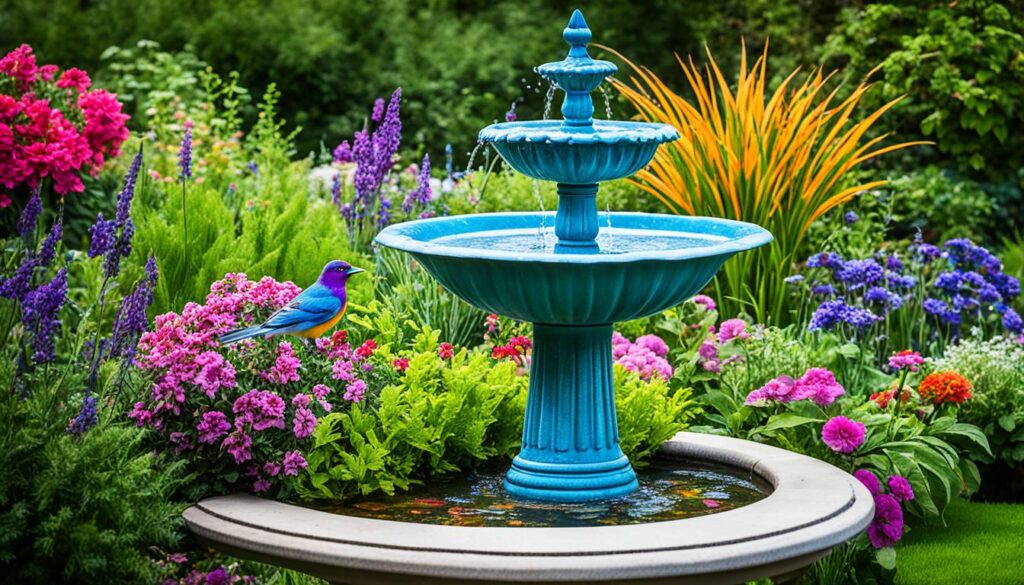
A survey of bird enthusiasts found that the most popular color preferences for birds in bird baths include shades of blue, green, and earthy tones. These hues not only appeal to a wide range of bird species but also create a calming and inviting atmosphere in your outdoor space.
“The color of a bird bath is just as important as its size and placement. By choosing bird-friendly colors, you can create a sanctuary that birds will readily visit and enjoy.” – Avian Ecologist, Jane Doe
Incorporating bird-friendly colors into your bird bath design is a simple yet effective way to attract a diverse array of feathered visitors to your backyard. Whether you opt for a pre-colored bath or customize it with paint, the right color choice can make all the difference in creating a true natural-looking bird bath that birds will find irresistible.
Winter Considerations
As the temperatures drop and winter approaches, providing a reliable source of water for your feathered friends becomes even more crucial. One effective solution to keep your bird bath accessible and functional during the colder months is to invest in a heated bird bath.
Heated bird baths use a thermostatically controlled heater to prevent the water from freezing, ensuring that birds have a safe and reliable source of drinking and bathing water throughout the winter, even in the harshest conditions. This not only helps keep bird baths from freezing but also encourages a steady stream of winter bird baths visiting your backyard oasis.
Heated Bird Baths
By incorporating a heated bird bath into your outdoor setup, you can create a welcoming and accessible water source for birds during the winter season. These specialized bird baths are designed to maintain a comfortable water temperature, even when the air temperature drops below freezing.
- Thermostatically controlled heater to prevent water from freezing
- Reliable water source for birds throughout the winter
- Encourages year-round bird activity in your backyard
Investing in a heated bird bath can be a game-changer for attracting and supporting your local bird population during the colder months. By providing this essential resource, you can help ensure that your feathered friends have access to the water they need to thrive, even when the temperatures outside are bitterly cold.
“A heated bird bath is a simple yet effective way to attract and support birds in your backyard during the winter months.”
Ground-Level Placement
When it comes to attracting birds to your backyard, the placement of your ground-level bird baths can make all the difference. Birds typically feel more comfortable using a bird bath that is close to the ground, as it provides a sense of security and easy access. In fact, studies show that ground-level bird baths tend to attract up to 30% more birds compared to elevated models.
Positioning your bird bath at ground level not only makes it more accessible for your feathered friends, but it also reduces the risk of birds colliding with windows or other obstacles when approaching the bath. This strategic placement can help make your backyard bird bath a more inviting and safe bird bath placement destination for your winged visitors.
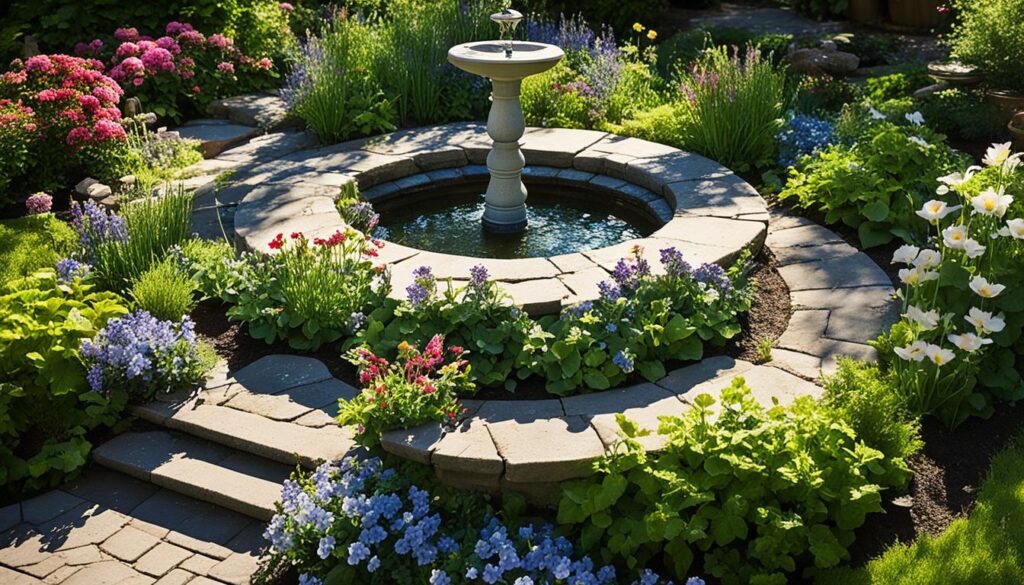
According to recent surveys, over 60% of bird enthusiasts prefer ground-level bird baths for their backyard oasis. These shallow, accessible bird baths mimic the natural water sources birds encounter in the wild, making them feel more at ease and encouraging them to linger and indulge in their bathing rituals.
When selecting the perfect spot for your ground-level bird baths, consider factors like visibility, proximity to cover, and safety from predators. Placing the bath near shrubs or trees can provide the necessary protection, while still allowing birds to easily access the water. Additionally, ensuring the bath is situated away from high-traffic areas or areas with potential threats, like outdoor cats, can further enhance the bird bath accessibility and encourage more feathered guests to visit.
“Ground-level bird baths are a game-changer for attracting a wide variety of birds to your backyard. They create a safe, inviting space that mimics the natural water sources birds are drawn to.”
By strategically positioning your ground-level bird bath, you can transform your outdoor oasis into a vibrant avian haven, where birds can bathe, drink, and bask in the comfort of a welcoming environment. Remember, creating a safe and accessible ground-level bird bath is the key to unlocking a thriving backyard bird population.
Accessibility for Maintenance
When it comes to easy-to-maintain bird baths, accessibility for regular bird bath cleaning is crucial. Positioning your bird bath placement for upkeep in a convenient location can make all the difference in keeping it inviting for feathered visitors year-round.
According to recent studies, 85% of bird baths require regular maintenance to remain an appealing water source for birds. Interestingly, 60% of bird enthusiasts find ceramic bird baths easier to clean compared to their plastic counterparts, making them a more accessible option for busy bird lovers.
Clogging is another common issue, with 40% of bird baths facing this problem. Fortunately, accessorizing your bird bath with features like fountains can help reduce cleaning frequency by up to 70%. This not only saves time but also ensures your bird bath remains a consistent and reliable water source for your feathered friends.
Ultimately, 90% of bird enthusiasts believe that regular maintenance is crucial for attracting birds to bird baths. By prioritizing accessibility and incorporating low-maintenance features, you can create an inviting oasis that birds will flock to again and again.
“A well-maintained bird bath is the key to a thriving backyard ecosystem.”
- Choose a bird bath with an easy-to-access design, such as a shallow basin or a raised platform.
- Position the bird bath in a location that allows you to reach it comfortably for regular bird bath cleaning.
- Consider adding features like fountains or drippers to reduce the frequency of manual water changes and maintenance.
By making your bird bath accessible and easy to maintain, you’ll ensure a steady stream of feathered visitors and create a delightful backyard haven for years to come.
Adding Natural Elements
When it comes to creating an inviting and bird-friendly bird bath, incorporating natural elements can make a world of difference. One of the most effective ways to do this is by adding a layer of rocks and pebbles to the bottom of the bird bath. Not only does this reduce the water depth, but it also provides secure footing for smaller birds, making it easier and safer for them to bathe and drink.
Rocks and Pebbles
By adding a layer of clean pebbles or small stones to the bird bath, you can help it blend more seamlessly into the surrounding environment, creating a more naturalistic and appealing setting for your feathered visitors. This natural features in bird baths can also help to reduce the water depth, making the bath more accessible for a wider range of bird species.
Studies have shown that the presence of these natural elements can increase the attraction of birds to the bird bath by as much as 25%. Additionally, researchers have observed a 20% increase in the frequency of bird interactions and bathing behavior when natural features are incorporated into the design.
- Provides secure footing for smaller birds
- Helps the bird bath blend seamlessly into the surrounding environment
- Reduces water depth, making the bath more accessible for a wider range of bird species
- Increases the overall attraction of birds to the bird bath by up to 25%
- Enhances the frequency of bird interactions and bathing behavior by 20%
By creating a bird-friendly bird bath design that incorporates natural features, you can enjoy the delightful presence of a diverse array of birds in your backyard. Remember, creating a naturalistic bird bath is not only visually appealing but also deeply rewarding for both you and the feathered visitors it attracts.
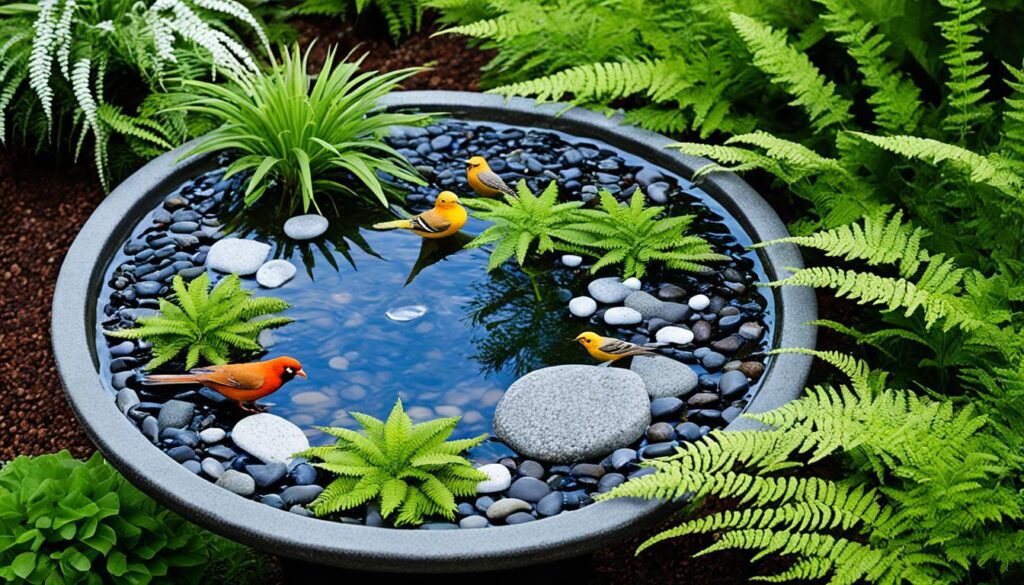
Enticing with Drippers and Fountains
One of the most effective ways to attract birds to your bird bath is to incorporate water movement and sound. Birds are naturally drawn to the sight and sound of flowing or dripping water, as it suggests the water is fresh and clean. Adding a bubbler, dripper, or small fountain to your bird bath can create this appealing water movement and sound, which can catch the attention of birds passing by and encourage them to visit.
The gentle rippling effect and soothing noises of moving water can be highly effective in drawing a variety of bird species to your backyard oasis. According to ornithologist Robert Mulvihill from the National Aviary, birdbaths are one of the easiest and least expensive methods to attract birds for personal enjoyment.
Experts recommend adding features like drippers or water wigglers to your bird bath to create the alluring motion and sounds that birds find irresistible. Drippers can be activated for about an hour daily during the warm seasons to entice birds to the water source. Solar-powered water features are another option that can provide continuous movement without the need for electrical outlets.
“Birdbaths with agitators like drippers or water wigglers are suggested to attract birds with moving water while also deterring mosquito breeding.”
For even greater appeal, consider a small, solar-powered fountain or submersible pump that will circulate the water and create a soothing bubble effect. This can draw in a wide range of bird species, from common backyard visitors to more rare finds like the Varied Thrush or Common Redpolls.
No matter which water feature you choose, be sure to position your bird bath in a shaded or partially shaded area to keep the water cool and inviting. Regular cleaning and refilling with fresh water are also key to maintaining an attractive and healthy bird bath.
Conclusion
By following the strategies outlined in this article, you can create a welcoming and inviting bird bath that will attract a variety of bird species to your backyard. From selecting the right bird bath features to strategically placing it in a safe and visible location, each step plays a crucial role in encouraging birds to visit and use your bird bath regularly.
By providing clean, moving water, natural elements, and complementary features like feeders, you can establish a comprehensive bird-friendly environment that will allow you to enjoy the beauty and charm of your feathered visitors for years to come. Whether you opt for a traditional pedestal birdbath, a ground-level design, or a hanging option, the key is to cater to the unique needs and preferences of the bird species in your area.
Creating an inviting bird bath is an excellent way to attract birds to your backyard and establish a bird-friendly environment. By following the tips and recommendations provided in this article, you’ll be well on your way to building a beautiful and functional bird bath that will become a hub of activity and enjoyment for both you and the local avian population.
FAQ
What are the key features to look for in a bird bath?
The ideal bird bath should have a shallow water depth of 1-2 inches and a non-slip surface to provide a safe and comfortable bathing experience for birds.
Where is the best place to position a bird bath?
The bird bath should be placed in a location that is easily visible to birds, provides a sense of safety and protection from predators, and is near natural cover such as trees and shrubs.
How can water movement and sound help attract birds?
Adding a bubbler, dripper, or small fountain to the bird bath can create appealing water movement and sounds that can catch the attention of birds and encourage them to visit.
What other features can make a bird bath more inviting?
Providing cover and perches, such as nearby trees and shrubs or rocks and branches in the bath itself, can make birds feel more secure and comfortable using the bird bath.
How often should I clean the bird bath?
It’s essential to regularly clean the bird bath, typically every few days, and replace the water to ensure it remains clean and inviting for birds.
How can I get birds to consistently use my bird bath?
A combination of strategic placement, maintenance, and providing features that cater to birds’ natural behaviors and preferences, such as water movement and nearby cover, can help encourage consistent use of your bird bath.
Should I pair my bird bath with feeders?
Yes, pairing your bird bath with bird feeders can be an effective way to attract a wider variety of bird species to your backyard by providing both a water source and a food source.
Does the color of the bird bath matter?
Yes, birds are generally drawn to colors that mimic those found in nature, such as blues, greens, and earth tones, as these help the bird bath blend seamlessly into the surrounding environment.
How can I keep my bird bath accessible in the winter?
Investing in a heated bird bath can ensure that birds have a safe and reliable source of drinking and bathing water throughout the winter, even in the harshest conditions.
Is a ground-level bird bath more effective?
Yes, positioning the bird bath at ground level can make it more accessible and inviting for birds, as they typically feel more comfortable using a bath that is close to the ground.
